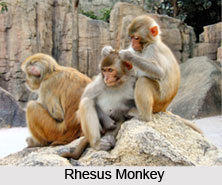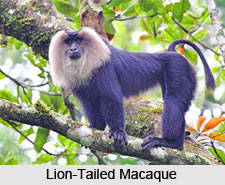 Macaque Monkey is a group of rather stocky thickset monkeys belonging to the genus Macaca which are distributed throughout the Indian subcontinent. Predominantly olive-brown in coloration with comparatively short tails, these monkeys are adapted to a widely varied diet most of which they glean from the ground so that they are not as dependent upon tall, tree forest as are the purely leaf-eating langurs.
Macaque Monkey is a group of rather stocky thickset monkeys belonging to the genus Macaca which are distributed throughout the Indian subcontinent. Predominantly olive-brown in coloration with comparatively short tails, these monkeys are adapted to a widely varied diet most of which they glean from the ground so that they are not as dependent upon tall, tree forest as are the purely leaf-eating langurs.
Rhesus Monkey - The best-known species is the common Rhesus Monkey (Macaca mulatta) which inhabits most of the northern parts of India and extends into the Himalayas of Pakistan. Its naked face is livid pink and it is the largest of the five species, adult males reaching up to ten kilograms in live weight. Easily recognized by the rusty orange fur on its hindquarters, it is replaced in south India by the Bonnet Macaque (Macaca radiata) which lacks the orange fur on its lower quarters but is distinguished instead by a whorl of longer darker hairs radiating from its fore-crown. They also have a comparatively longer tail than the Rhesus, indicative of more arboreal habits. Adult males rarely weigh more than eight kilograms.
Assamese Macaque - In Assam and Chittagong region of Bangladesh, the Assamese Macaque (Macaca assamensis) is also a larger and heavier monkey, equally at home in the tropical rain-forest of Sylhet and Assam or the mangrove forests in the Sunderban, in which region it is largely dependent on a diet of crabs.
 Lion-Tailed Macaque - In the Nilgiri Hills and Western Ghats a remnant population of the much rarer Lion-tailed Macaque is now in danger of extinction due to the gradual destruction of the evergreen rain-forest upon which it depends. Unlike all other macaques, this striking monkey has a naked black face framed by a long lion-like ruff of white hairs, whilst the rest of its body-fur is black.
Lion-Tailed Macaque - In the Nilgiri Hills and Western Ghats a remnant population of the much rarer Lion-tailed Macaque is now in danger of extinction due to the gradual destruction of the evergreen rain-forest upon which it depends. Unlike all other macaques, this striking monkey has a naked black face framed by a long lion-like ruff of white hairs, whilst the rest of its body-fur is black.
Pig-Tailed Macaque - The Pig-tailed Macaque is found in Nagaland.
Stump-Tailed Macaque - Finally in the north-eastern extremity of Assam, in the hill forests, the Stump-tailed macaque (macaca speciosa) is found, which has a tail barely 25 centimetres long. It is said to be more insectivorous in diet than the other macaques.
Significance of Macaque Monkeys
Macaque monkeys are important to man in that they have been extensively used for testing of newly developed drugs and in particular for the development of the Salk vaccine against poliomyelitis. The export of Rhesus monkeys for this purpose is now restricted, due to an increasing realization that wild stocks are being rapidly depleted by this trade. All these species are markedly social, living in fairly cohesive bands of from twenty to seventy individuals in which one male is the dominant leader. Studies have shown that an equally large female is often the second ranking individual in the tribe. Diurnal in feeding, the whole troop usually retires to one group of trees or sheer cliffs for the night and where persecuted, they are shy and wary. In some parts of India, they are adapted to live commensally with man in the towns and villages and for reasons of sentiment and religion they are not molested despite their marauding and destructive habits.











